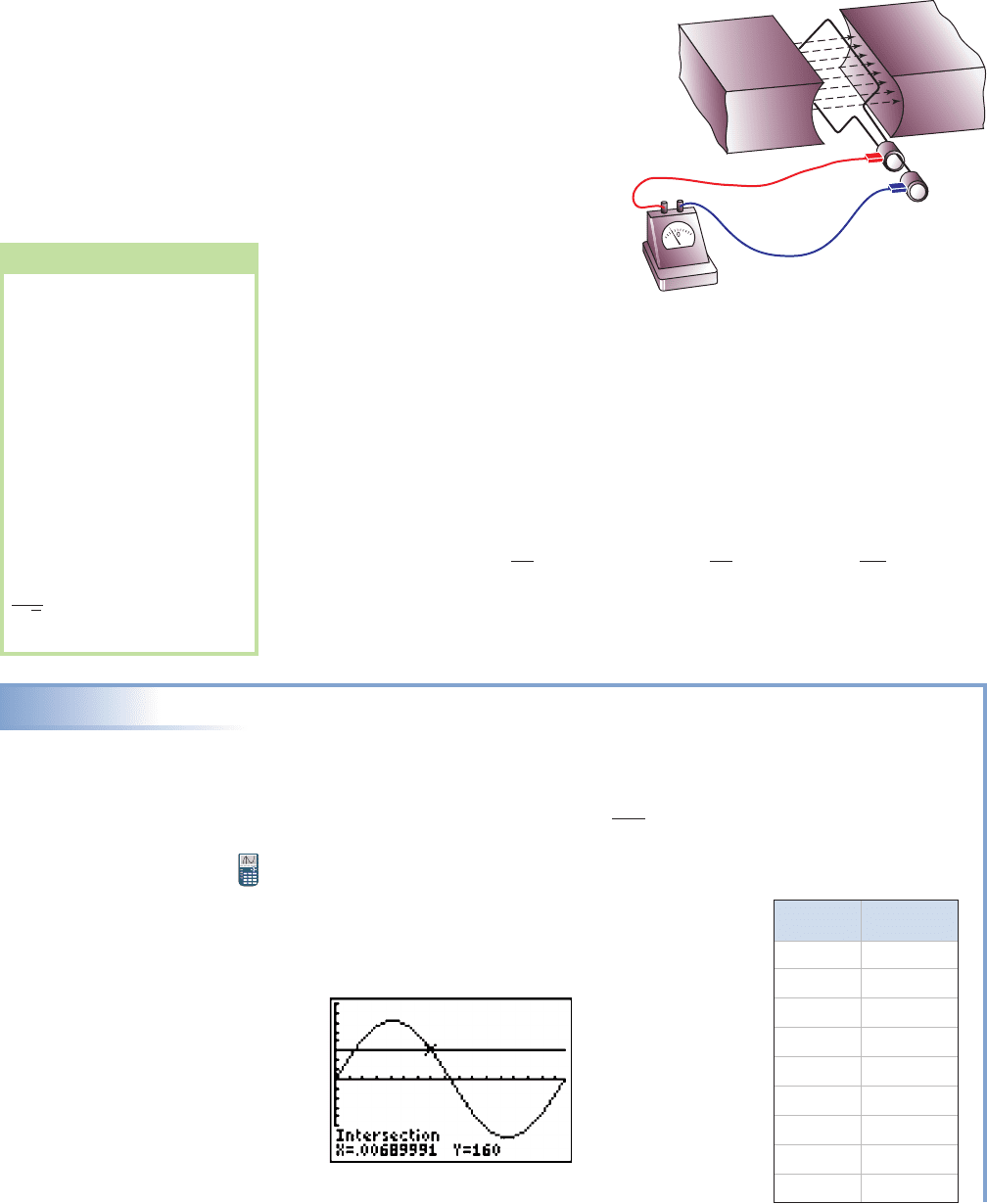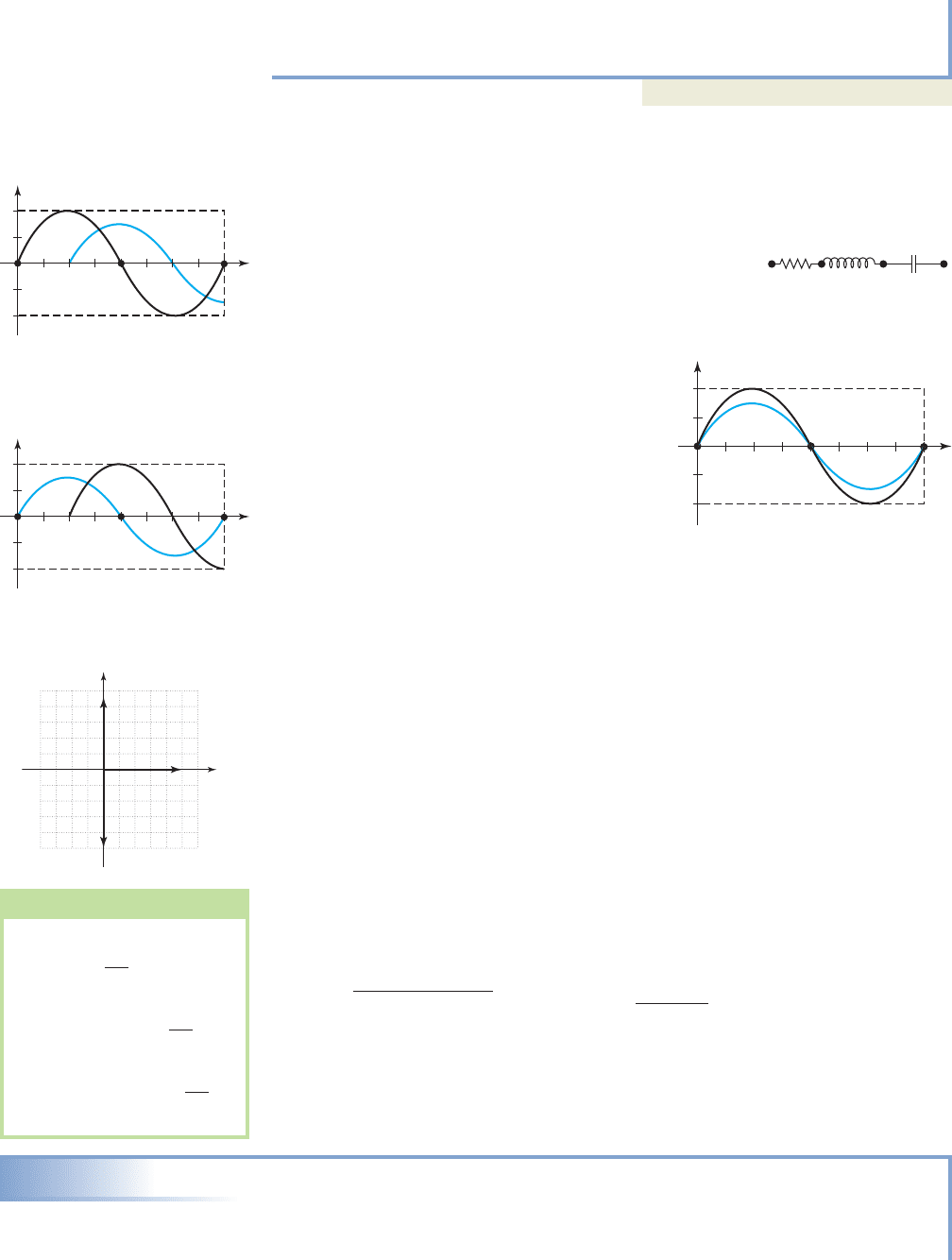Coburn J.W. Algebra and Trigonometry
Подождите немного. Документ загружается.


770 CHAPTER 7 Applications of Trigonometry 7-60
Products and Quotients of Complex Numbers in Trigonometric Form
For the complex numbers and
and
EXAMPLE 5
Multiplying Complex Numbers in Trigonometric Form
For and
a. Write z
1
and z
2
in trigonometric form and compute z
1
z
2
.
b. Compute the quotient in trigonometric form.
c. Verify the product using the rectangular form.
Solution
a. For z
1
in QII we find and for z
2
in QI, and
In trigonometric form,
and
multiply moduli, add arguments
b.
divide moduli, subtract arguments
c.
Now try Exercises 39 through 46
Converting to trigonometric form for multiplication and division seems too clumsy
for practical use, as we can often compute these results more efficiently in rectangu-
lar form. However, this approach leads to powers and roots of complex numbers, an
indispensable part of advanced equation solving, and these are not easily found in
rectangular form. In any case, note that the power and simplicity of computing
products/quotients in trigonometric form is highly magnified when the complex
numbers are given in trig form:
See Exercises 47 through 50.
112 cis 50°213 cis 20°2 36 cis 70°
12 cis 50°
3 cis 20°
4 cis 30°.
413
313 3i 3i 13i
2
z
1
z
2
13 13i2113 1i2
13
2
3
2
i
13
a
1
2
13
2
ib
13
1cos 120° i sin 120°2
13
3cos1150° 30°2 i sin1150° 30°24
z
1
z
2
213
1cos 150° i sin 150°2
21cos 30° i sin 30°2
413
413 11 0i2
413
1cos 180° i sin 180°2
213
#
23cos1150° 30°2 i sin1150° 30°24
z
1
z
2
2131cos 150° i sin 150°2
#
21cos 30° i sin 30°2
z
2
21cos 30° i sin 30°2:
z
1
2131cos 150° i sin 150°2
30°.r 2 150°,r 213
z
1
z
2
z
2
13 1i,z
1
3 13i
z
1
z
2
r
1
r
2
3cos1 2 i sin1 24, z
2
0.
z
1
z
2
r
1
r
2
3cos1 2 i sin1 24
z
2
r
2
1cos i sin 2,
z
1
r
1
1cos i sin 2
E. You’ve just learned how
to compute products and
quotients in trigonometric
form
College Algebra & Trignometry—
cob19529_ch07_766-776.qxd 11/19/08 2:32 AM Page 770 epg HD 049:Desktop Folder:Satya 18/11/08:

7-61 Section 7.5 Complex Numbers in Trigonometric Form 771
F. (Optional) Applications of Complex Numbers
Somewhat surprisingly, complex numbers
have several applications in the real
world. Many of these involve a study of
electricity, and in particular AC (alter-
nating current) circuits.
In simplistic terms, when an arma-
ture (molded wire) is rotated in a
uniform magnetic field, a voltage V is
generated that depends on the strength of
the field. As the armature is rotated, the
voltage varies between a maximum and
a minimum value, with the amount of
voltage modeled by
with in degrees. Here, V
max
represents
the maximum voltage attained, and the
input variable represents the angle the armature makes with the magnetic flux, indi-
cated in Figure 7.74 by the dashed arrows between the magnets.
When the armature is perpendicular to the flux, we say At and
no voltage is produced, while at and the voltage reaches
its maximum and minimum values respectively (hence the name alternating current).
Many electric dryers and other large appliances are labeled as 220 volt (V) appliances,
but use an alternating current that varies from 311 V to (see Worthy of Note).
This means when is being generated. In
practical applications, we use time t as the independent variable, rather the angle of
the armature. These large appliances usually operate with a frequency of 60 cycles per
second, or 1 cycle every of a second Using we obtain
and our equation model becomes with t in radians.
This variation in voltage is an excellent example of a simple harmonic model.
EXAMPLE 6
Analyzing Alternating Current Using Trigonometry
Use the equation to:
a. Create a table of values illustrating the voltage produced every thousandth of a
second for the first half-cycle
b. Use a graphing calculator to find the times t in this half-cycle when 160 V is
being produced.
Solution
a. Starting at and using increments of
0.001 sec produces the table shown.
t 0
at
1
120
0.008b.
V1t2 311 sin1120t2
V1t2 311 sin1120t2
B 120
B
2
P
,aP
1
60
b.
1
60
V152°2 311 sin152°2 245 V 52°,
311 V
270°, 90° 180°,
0° 0°.
V12 V
max
sin1B2,
WORTHY OF NOTE
You may have wondered why
we’re using an amplitude of
311 for a 220-V appliance.
Due to the nature of the sine
wave, the average value of
an alternating current is
always zero and gives no
useful information about the
voltage generated. Instead,
the root-mean-square (rms)
of the voltage is given on
most appliances. While the
maximum voltage is 311 V,
the rms voltage is
See
Exercise 72.
311
12
220 V.
Time t Voltage
00
0.001 114.5
0.002 212.9
0.003 281.4
0.004 310.4
0.005 295.8
0.006 239.6
0.007 149.8
0.008 39.9
N
S
Magnetic flux
Figure 7.74
400
400
0 0.0165
College Algebra & Trignometry—
cob19529_ch07_766-776.qxd 11/19/08 2:32 AM Page 771 epg HD 049:Desktop Folder:Satya 18/11/08:

772 CHAPTER 7 Applications of Trigonometry 7-62
b. From the table we note when and
. Using the intersection of graphs method places these values
at and (see graph).
Now try Exercises 53 and 54
The chief components of AC circuits are voltage (V) and current (I). Due to the
nature of how the current is generated, V and I can be modeled by sine functions. Other
characteristics of electricity include pure resistance (R),
inductive reactance (X
L
), and capacitive reactance (X
C
)
(see Figure 7.75). Each of these is measured in a unit called
ohms ( while current I is measured in amperes (A), and
voltages are measured in volts (V). These components of
electricity are related by fixed and inherent traits,
which include the following: (1) voltage across a
resistor is always in phase with the current,
meaning the phase shift or phase angle between
them is (Figure 7.76);(2) voltage across an
inductor leads the current by (Figure 7.77);
(3) voltage across a capacitor lags the current by
(Figure 7.78); and (4) voltage is equal to the
product of the current times the resistance or
reactance: and
Different combinations of R, X
L
, and X
C
in a
combined (series) circuit alter the phase angle and the resulting voltage. Since voltage
across a resistance is always in phase with the current (trait 1), we can model the resis-
tance as a vector along the positive real axis (since the phase angle is ). For traits
(2) and (3), X
L
is modeled on the positive imaginary axis since voltage leads current
by and X
C
on the negative imaginary axis since voltage lags current by (see
Figure 7.79). These natural characteristics make the complex plane a perfect fit for
describing the characteristics of the circuit.
Consider a series circuit (Figure 7.75), where and
For a current of through this circuit, the voltage across each
individual element would be (A to B),
(B to C), and (C to D). However, the resulting voltage across this
circuit cannot be an arithmetic sum, since R is real while X
L
and X
C
are represented by
imaginary numbers. The joint effect of resistance (R) and reactance (X
L
, X
C
) in a circuit
is called the impedance, denoted by the letter Z, and is a measure of the total resis-
tance to the flow of electrons. It is computed (see Worthy of
Note), due to the phase angle relationship of the voltage in each element (X
L
and X
C
point in opposite directions, hence the subtraction). The expression for Z is more
commonly written where we more clearly note Z is a complex
number whose magnitude and angle with the x-axis can be found as before:
and The angle represents the
phase angle between the voltage and current brought about by this combination of ele-
ments. The resulting voltage of the circuit is then calculated as the product of the
current with the magnitude of the impedance, or (Z is also measured in
ohms, ).
EXAMPLE 7
Finding the Impedence and Phase Angle of the Current in a Circuit
For the circuit diagrammed in the figure, (a) find the magnitude of Z, the phase
angle between current and voltage, and write the result in trigonometric form; and
(b) find the total voltage across this circuit.
V
RLC
I
Z
r
tan
1
a
X
L
X
C
R
b.
Z
2R
2
1X
L
X
C
2
2
R 1X
L
X
C
2j,
Z R X
L
j X
C
j
V
C
122142 8 V
V
L
122192 18 VV
R
1221122 24 V
I 2 amps
X
C
4 .
R 12 , X
L
9 ,
90°90°,
0°
V IX
C
.V IR, V IX
L
,
90°
90°
0°
2,
t 0.0069t 0.0014
t 10.006, 0.0072
t 10.001, 0.0022V1t2 160
X
C
X
L
R
A
BCD
sin
Voltage and current
are in phase
(phase angle 0)
90 180 270
sin
Voltage leads current
by 90
(phase angle 90)
90 180 270
sin
Voltage lags current
by 90
(phase angle 90)
90 180 270
R
X
L
X
C
x
yi
Figure 7.75
Figure 7.76
Figure 7.77
Figure 7.78
Figure 7.79
WORTHY OF NOTE
While mathematicians
generally use the symbol i to
represent the “i” is
used in other fields to
represent an electric current
so the symbol is
used instead. In conformance
with this convention, we will
temporarily use j for
as well.
11
j 11
11,
College Algebra & Trignometry—
cob19529_ch07_766-776.qxd 11/19/08 2:32 AM Page 772 epg HD 049:Desktop Folder:Satya 18/11/08:

7-63 Section 7.5 Complex Numbers in Trigonometric Form 773
Solution
a. Using the values given, we find
(QI). This gives a magnitude of
with a phase angle of
(voltage leads the current by about ).
In trigonometric form
b. With the total voltage across this circuit is
Now try Exercises 55 through 68
V
RLC
I
Z
21132 26 V.
I 2 amps,
Z 13 cis 22.6°.
22.6° tan
1
a
5
12
b 22.6°
Z
21122
2
152
2
1169 13 ,
12 19 42j 12 5j
Z R 1X
L
X
C
2j
4 Ω9 Ω12 Ω
X
C
X
L
R
AB C D
F. You have just learned
how to solve applications
involving complex numbers
CONCEPTS AND VOCABULARY
Fill in each blank with the appropriate word or phrase.
Carefully reread the section if needed.
1. For a complex number written in the form
r is called the
and is called the .
2. The complex number
can be written as the abbreviated “cis” notation as
.
3. To multiply complex numbers in trigonometric
form, we the moduli and
the arguments.
z 2ccosa
4
b i sina
4
bd
z r 1cos i sin 2,
4. To divide complex numbers in trigonometric form,
we the moduli and the
arguments.
5. Write in trigonometric form and
explain why the argument is instead of
as indicated by your calculator.
6. Discuss the similarities between finding the
components of a vector and writing a complex
number in trigonometric form.
60°
240°
z 1 13
i
DEVELOPING YOUR SKILLS
Graph the complex numbers z
1
, z
2
, and z
3
given, then
express one as the sum of the other two.
7. 8.
9. 10.
State the quadrant of each complex number, then write
it in trigonometric form. For Exercises 11 through 14,
answer in degrees. For 15 through 18, answer in
radians.
11. 12. 7 7i2 2i
z
3
5 4iz
3
3 2i
z
2
7 2iz
2
1 7i
z
1
2 6iz
1
2 5i
z
3
1 3iz
3
1 4i
z
2
3 4iz
2
8 6i
z
1
2 7iz
1
7 2i
13. 14.
15. 16.
17. 18.
Write each complex number in trigonometric form. For
Exercises 19 through 22, answer in degrees using both
an exact form and an approximate form, rounding to
tenths. For 23 through 26, answer in radians using both
an exact form and an approximate form, rounding to
four decimal places.
19. 20.
21. 22.
23. 24.
25. 26.
12 4i6 10i
30 5.5i6 17.5i
8 15i5 12i
9 12i8 6i
6 613
i413 4i
517
517i312 312i
2 213
i513 5i
7.5 EXERCISES
College Algebra & Trignometry—
cob19529_ch07_766-776.qxd 01/13/2009 09:51 PM Page 773 ssen 1 HD 049:Desktop Folder:Satya 13/01/09:Used file:MHDQ092-7.5:

Graph each complex number using its trigonometric
form, then convert each to rectangular form.
27. 28.
29. 30.
31. 32.
33.
34.
For the complex numbers z
1
and z
2
given, find their
moduli r
1
and r
2
and arguments and
.
Then compute
their product in rectangular form. For modulus r and
argument of the product, verify that and
35.
36.
For the complex numbers z
1
and z
2
given, find their
moduli r
1
and r
2
and arguments and Then
compute their quotient in rectangular form. For
modulus r and argument of the quotient, verify that
and
37.
38.
z
1
13 i;
z
2
3 0i
z
1
13 i;
z
2
1 13i
1
2
.
r
1
r
2
r
2
.
1
z
1
1 13i;
z
2
3 13i
z
1
2 2i;
z
2
3 3i
1
2
.
r
1
r
2
r
2
1
4 cisc tan
1
a
17
3
bd
6 cisc tan
1
a
5
111
bd
10 cisctan
1
a
3
4
bd17 cisctan
1
a
15
8
bd
513
cis a
7
6
b413 cis a
3
b
12 cis
a
6
b2 cis
a
4
b
Compute the product z
1
z
2
and quotient using the
trigonometric form. Answer in exact rectangular form
where possible, otherwise round all values to two
decimal places.
39.
41. 42.
43.
44.
45.
46.
47. 48.
49. 50.
z
2
8 cis 275°z
2
1.5 cis 27°
z
1
1.6 cis 59°z
1
6 cis 82°
z
2
13 cis 90°z
2
212 cis 30°
z
1
513 cis 240°z
1
512 cis 210°
z
2
21cos 300° i sin 300°2
z
1
71cos 120° i sin 120°2
z
2
41cos 30° i sin 30°2
z
1
101cos 60° i sin 60°2
z
2
8.4ccos a
5
b i sin a
5
bd
z
1
2ccos a
3
5
b i sin a
3
5
bd
z
2
1.8ccos a
2
3
b i sin a
2
3
bd
z
1
9ccos a
15
b i sin a
15
bd
z
2
312
2
3i16
2
z
2
21
2
7i13
2
z
1
0 6i12z
1
213 0i
z
2
313
2
3
2
i
z
1
413 4i
z
1
z
2
774 CHAPTER 7 Applications of Trigonometry 7-64
40.
z
2
0 6i
z
1
513
2
5
2
i
WORKING WITH FORMULAS
51. Equilateral triangles in the complex plane:
If the line segments connecting the complex
numbers u, v, and w form the vertices of an
equilateral triangle, the formula shown above holds
true. Verify that and
form the vertices of an equilateral
triangle using the distance formula, then verify the
formula given.
w 6 513
i
v 10 13
i,u 2 13i,
u
2
v
2
w
2
uv uw vw
52. The cube of a complex number:
The cube of any binomial can be found using the
formula here, where A and B are the terms of the
binomial. Use the formula to compute the cube of
(note and B 2i2.A 11 2i
1A B2
3
A
3
3A
2
B 3AB
2
B
3
APPLICATIONS
53. Electric current: In the United States, electric
power is supplied to homes and offices via a “120
V circuit,” using an alternating current that varies
from 170 V to , at a frequency of 60
cycles/sec. (a) Write the voltage equation for U.S.
170 V
households, (b) create a table of values illustrating
the voltage produced every thousandth of a second
for the first half-cycle, and (c) find the first time t
in this half-cycle when exactly 140 V is being
produced.
College Algebra & Trignometry—
cob19529_ch07_766-776.qxd 12/27/08 16:31 Page 774

54. Electric current: While the electricity supplied in
Europe is still not quite uniform, most countries
employ 230-V circuits, using an alternating current
that varies from 325 V to . However, the
frequency is only 50 cycles per second. (a) Write
the voltage equation for these European countries,
(b) create a table of values illustrating the voltage
produced every thousandth of a second for the first
half-cycle, and (c) find the first time t in this half-
cycle when exactly 215 V is being produced.
AC circuits: For the circuits indicated in Exercises 55
through 60, (a) find the magnitude of Z, the phase angle
between current and voltage, and write the result in
trigonometric form; and (b) find the total voltage across
this circuit. Recall and
55. and
with
56.
and with
57. and
with
58. and
with
59. and with
60. and , with
AC circuits—voltage: The current I and the impedance
Z for certain AC circuits are given. Write I and Z in
I 4 A.X
L
12 R 35
I 1.7 A.X
L
5 ,R 12
I 2.0 A.X
C
8.3 ,
R 9.2 , X
L
5.6 ,
I 1.8 A.X
C
11 ,
R 7 , X
L
6 ,
I 2.5 A.X
C
5 ,
R 24 , X
L
12 ,
I 3 A.X
C
4 ,
R 15 , X
L
12 ,
|Z| 1R
2
(X
L
X
C
)
2
.
Z R (X
L
X
C
) j
325 V
trigonometric form and find the voltage in each circuit.
Recall
61. and
62. and
63. and
64. and
AC circuits—current: If the voltage and impedance are
known, the current I in the circuit is calculated as the
quotient Write V and Z in trigonometric form to
find the current in each circuit.
65. and
66. and
67. and
68. and
Parallel circuits: For AC circuits wired in parallel, the
total impedance is given by where Z
1
and
Z
2
represent the impedance in each branch. Find the
total impedance for the values given. Compute the
product in the numerator using trigonometric form, and
the sum in the denominator in rectangular form.
69. and
70. and Z
2
2 jZ
1
3 j
Z
2
3 2jZ
1
1 2j
Z
Z
1
Z
2
Z
1
Z
2
,
Z 1.4 4.8j V 2.8 9.6j
Z 4 7.5j V 3 4j
Z 1 1j V 413
4j
Z 4 4j V 2 213
j
I
V
Z
.
Z 2 4j I 4 3j A
Z 2 3.75j I 3 2j A
Z 2 2j I 13
1j A
Z 5 5j I 13
1j A
V IZ.
7-65
Section 7.5 Complex Numbers in Trigonometric Form 775
EXTENDING THE CONCEPT
71. Verify/prove that for the complex numbers
and
72. Using the Internet, a trade manual, or some other
resource, find the voltage and frequency at which
electricity is supplied to most of Japan (oddly
enough—two different frequencies are in common
use). As in Example 6, the voltage given will likely
be the root-mean-square (rms) voltage. Use the
information to find the true voltage and the
equation model for voltage in most of Japan.
z
1
z
2
r
1
r
2
3cos1 2 i sin1 24.
z
2
r
2
1cos i sin 2,
z
1
r
1
1cos i sin 2
73. Recall that two lines are perpendicular if their
slopes have a product of For the directed line
segment representing the complex number
find complex numbers z
2
and z
3
whose directed line segments are perpendicular to
z
1
and have a magnitude one-fifth as large.
74. The magnitude of the impedance is
If R, X
L
, and X
C
are all
nonzero, what conditions would make the
magnitude of Z as small as possible?
Z
2R
2
1X
L
X
C
2
2
.
z
1
7 24i,
1.
X
C
X
L
R
A
BC D
X
L
R
A
B
C
Exercises 55 through 58
Exercises 59 and 60
College Algebra & Trignometry—
cob19529_ch07_766-776.qxd 12/27/08 16:32 Page 775

776 CHAPTER 7 Applications of Trigonometry 7-66
MAINTAINING YOUR SKILLS
75. (6.7) Solve for
76. (3.6) Name all asymptotes of the function
77. (2.7) Graph the piecewise-defined function given:
f 1x2 •
2 x 6 2
x
2
2 x 6 1
x x 1
h1x2
1 x
3
x
2
350 750 sina2x
4
b 25
x 30, 22:
78. (7.2) A ship is spotted by two observation posts that
are 4 mi apart. Using the line between them for
reference, the first post reports the ship is at an angle
of while the second reports an angle of as
shown. How far is the ship from the closest post?
41 63
4 mi
63°,41°,
The material in this section represents some of the most significant developments in the
history of mathematics. After hundreds of years of struggle, mathematical scientists had
not only come to recognize the existence of complex numbers, but were able to make
operations on them commonplace and routine. This allowed for the unification of many
ideas related to the study of polynomial equations, and answered questions that had
puzzled scientists from many different fields for centuries. In this section, we will look
at two fairly simple theorems that actually represent over 1000 years in the evolution
of mathematical thought.
A. De Moivre’s Theorem
Having found acceptable means for applying the four basic operations to complex
numbers, our attention naturally shifts to the computation of powers and roots. Without
them, we’d remain wholly unable to offer complete solutions to polynomial equations
and find solutions for many applications. The computation of powers, squares, and
cubes offer little challenge, as they can be computed easily using the formula for bino-
mial squares or by applying the binomial theorem.
For larger powers, the binomial theorem becomes too time consuming and a more effi-
cient method is desired. The key here is to use the trigonometric form of the complex
number. In Section 7.5, we noted the product of two complex numbers involved mul-
tiplying their moduli and adding their arguments:
For and we have
For the square of a complex number, and Using itself yields
r
2
3cos122 i sin1224
z
2
r
2
3cos1 2 i sin1 24
1
2
.r
1
r
2
z
1
z
2
r
1
r 3cos1
1
2
2 i sin1
1
2
24
z
2
r
2
1cos
2
i sin
2
2z
1
r
1
1cos
1
i sin
1
2
31A B2
2
A
2
2AB B
2
4
Learning Objectives
In Section 7.6 you will learn how to:
A. Use De Moivre’s
theorem to raise
complex numbers to
any power
B. Use De Moivre’s
theorem to check
solutions to polynomial
equations
C. Use the nth roots
theorem to find the nth
roots of a complex
number
7.6 De Moivre’s Theorem and the Theorem on nth Roots
Exercise 78
College Algebra & Trignometry—
cob19529_ch07_766-776.qxd 12/27/08 16:32 Page 776

College Algebra & Trignometry—
7-67
Section 7.6 De Moivre’s Theorem and the Theorem on nth Roots 777
Multiplying this result by to compute z
3
gives
The result can be extended further and generalized into De Moivre’s theorem.
De Moivre’s Theorem
For any positive integer n, and
For a proof of the theorem where n is an integer and see Appendix V.
EXAMPLE 1
Using De Moivre’s Theorem to Compute the Power of a Complex Number
Use De Moivre’s theorem to compute z
9
, given
Solution
Here we have With z in QIII, yields
The trigonometric form is and applying
the theorem with gives
De Moivre’s theorem
simplify
coterminal angles
evaluate functions
result
Now try Exercises 7 through 14
As with products and quotients, if the complex number is given in trigonometric
form, computing any power of the number is both elegant and efficient. For instance,
if then See Exercises 15 through 18.
For cases where is not a standard angle, De Moivre’s theorem requires an intriguing
application of the skills developed in Chapter 6, including the use of multiple angle
identities and working from a right triangle drawn relative to
See Exercises 57 and 58.
B. Checking Solutions to Polynomial Equations
One application of De Moivre’s theorem is checking the complex roots of a polyno-
mial, as in Example 2.
r
tan
1
a
b
a
b.
z
4
16 cis 160°.z 2 cis 40°,
1
32
1
32
i
12
32
a
12
2
12
2
ib
12
32
ccosa
5
4
b i sina
5
4
bd
12
32
ccosa
45
4
b i sina
45
4
bd
z
9
a
12
2
b
9
ccosa9
#
5
4
b i sina9
#
5
4
bd
n 9
z
12
2
ccosa
5
4
b i sina
5
4
bd
5
4
.
tan 1
r
B
a
1
2
b
2
a
1
2
b
2
12
2
.
z
1
2
1
2
i.
n 1,
z
n
r
n
3cos1n2 i sin1n24
z r1cos i sin 2,
r
3
3cos132 i sin1324.
r
2
3cos122 i sin1224 r1cos i sin 2 r
3
3cos12 2 i sin12 24
z r1cos i sin 2
WORTHY OF NOTE
Sometimes the argument of
cosine and sine becomes
very large after applying De
Moivre’s theorem. In these
cases, we use the fact that
and
represent coter-
minal angles for integers k,
and use the coterminal angle
where or
0 6 2.
0 6 360°
2 k
360°k
A. You’ve just learned how
to use De Moivre’s theorem to
raise complex numbers to any
power
cob19529_ch07_777-783.qxd 12/27/08 19:13 Page 777

778 CHAPTER 7 Applications of Trigonometry 7-68
EXAMPLE 2
Using De Moivre’s Theorem to Check Solutions to a Polynomial Equation
Use De Moivre’s theorem to show that is a solution to
Solution
We will apply the theorem to the third and fourth degree terms, and compute the
square directly. Since z is in QIII, the trigonometric form is In the
following illustration, note that and are coterminal, as are and
Substituting back into the original equation gives
✓
Now try Exercises 19 through 26
Regarding Example 2, we know from a study of algebra that complex roots must
occur in conjugate pairs, meaning is also a root. This equation actually has
two real and two complex roots, with and being the two real roots.
C. The nth Roots Theorem
Having looked at De Moivre’s theorem, which raises a complex number to any power,
we now consider the nth roots theorem, which will compute the nth roots of a
complex number. If we allow that De Moivre’s theorem also holds for rational values
instead of only the integers n illustrated previously, the formula for computing an
nth root would be a direct result:
De Moivre’s theorem
simplify
However, this formula would find only the principal nth root! In other words, peri-
odic solutions would be ignored. As in Section 7.5, it’s worth noting the most general
form of a complex number is for
When De Moivre’s theorem is applied to this form for integers n, we obtain
which returns a result identical to
However, for the rational exponent the general form takes
additional solutions into account and will return all n, nth roots.
simplify 1
n
rccosa
n
360°k
n
b i sina
n
360°k
n
bd
z
1
n
r
1
n
ecosc
1
n
1 360°k2d i sinc
1
n
1 360°k2df
1
n
,r
n
3cos1n2 i sin1n24.
z
n
r
n
3cos1n 360°kn2 i sin1n 360°kn24,
k .z r3cos1 360°k2 i sin1 360°k24,
1
n
rccosa
n
b i sina
n
bd
z
1
n
r
1
n
ccosa
1
n
b i sina
1
n
bd
1
n
,
z 2z 9
2 2i
0 0
164 48 256 1442 148 304 2562i 0
64 48 48i 304i 256 256i 144 0
1 1642 3116 16i2 3818i2 12812 2i2 144 0
1 z
4
3z
3
38z
2
128z 144 0
8i 16 16i 64
0 8i 1612
a
12
2
12
2
ib 6411 0i2
4 8i 4 1212
2
3
cis 315° 64 cis 180°
4 8i 4i
2
12122
3
cis 675° 12122
4
cis 900°
4 8i 12i2
2
12122
3
cis13
#
225°2 12122
4
cis14
#
225°2
12 2i2
2
12 2i2
3
12 2i2
4
315°.675°180°900°
z 212
cis 225°.
z
4
3z
3
38z
2
128z 144 0.
z 2 2i
B. You’ve just learned to
use De Moivre’s theorem to
check solutions to polynomial
equations
De Moivre’s
theorem for rational
exponents
College Algebra & Trignometry—
cob19529_ch07_777-783.qxd 11/19/08 2:33 AM Page 778 epg HD 049:Desktop Folder:Satya 18/11/08:

x
yi
z
3
z
2
z
1
120
120
(1, 0)
120
q, ]
√3
q, ]
√3
7-69 Section 7.6 De Moivre’s Theorem and the Theorem on nth Roots 779
The nth Roots Theorem
For a positive integer n, and z has exactly n distinct
nth roots determined by
where
For ease of computation, it helps to note that once the argument for the principal
root is found using simply adds to the previous
argument for
In Example 3 you’re asked to find the three cube roots of 1, also called the cube
roots of unity, and graph the results. The nth roots of unity play a significant role in
the solution of many polynomial equations. For an in-depth study of this connection,
visit www.mhhe.com/coburn and go to Section 7.8: Trigonometry, Complex
Numbers and Cubic Equations.
EXAMPLE 3
Finding nth Roots
Use the nth roots theorem to solve the equation Write the results in
rectangular form and graph.
Solution
From we have and must find the three cube roots of unity. As
before, we begin in trigonometric form:
With and we have
and The principal
root ( ) is
Adding to each previous argument, we find
the other roots are
.
In rectangular form these are and
as shown in the figure.
Now try Exercises 27 through 40
EXAMPLE 4
Finding nth Roots
Use the nth roots theorem to find the five fifth roots of
Solution
In trigonometric form, With
, and we have and
The principal root is
Adding to each previous argument, we find the other four roots are
Now try Exercises 41 through 44
z
4
21cos 294° i sin 294°2z
3
21cos 222° i sin 222°2
z
2
21cos 150° i sin 150°2z
1
21cos 78° i sin 78°2
72°
z
0
21cos 6° i sin 6°2.
30°
5
360°k
5
6° 72°k.
1
5
r 1
5
32 2, 30°,n 5, r 32
1613
16i 321cos 30° i sin 30°2.
z 1613
16i.
1
2
13
2
i,
1
2
13
2
i,
z
2
11cos 240° i sin 240°2
z
1
11cos 120° i sin 120°2
120°
z
0
11cos 0° i sin 0°2 1.k 0
0°
3
360°k
3
0° 120°k.
1
3
r 1
3
1 1, 0°,n 3, r 1,
1 0i 11cos 0° i sin 0°2.
x
3
1x
3
1 0,
x
3
1 0.
k 1, 2, 3, # # # , n 1.
360
n
aor
2
n
bk 0,
n
360°k
n
k 0, 1, 2, # # # , n 1.
1
n
z 1
n
rccosa
n
360°k
n
b i sina
n
360°k
n
bd
r ,z r1cos i sin 2,
College Algebra & Trignometry—
cob19529_ch07_777-783.qxd 11/19/08 2:33 AM Page 779 epg HD 049:Desktop Folder:Satya 18/11/08:
